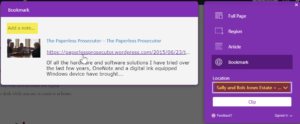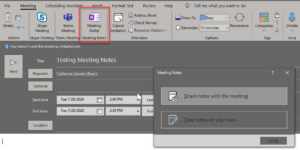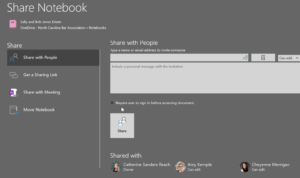Microsoft OneNote: Your Electronic Trapper Keeper
Law firms have used Microsoft OneNote to help corral firm information both in litigation and in transactional practices. The product is part of the Microsoft 365 suite, but rumors of the demise of the software and other issues may have scared lawyers off from exploring it as an option. Learn the latest on the product and how law firms can use it in their practice to organize and access information.
Current News on OneNote
In April 2018 Microsoft declared its intention to cease development and support for MS OneNote 2016, urging users instead to use the Windows 10 version. Most people consider the Windows 10 “lite” in many ways and it is a different interface and not as feature rich. For some that is a blessing, others a curse. Microsoft announced, after a considerable amount of push back, that it would continue to support and deploy OneNote 2016 and also push it out with Office 2019. Now OneNote 2016 will be installed when you download the Microsoft 365 office suite software. But for a short period of time the install was not part of the suite. If you purchased Microsoft 365 before March 2020 and do not see OneNote 2016 in your program list you can download it here. Confusing? You betcha! Microsoft provides an FAQ to try to explain. The short version is that you can run both OneNote for Windows 10 and OneNote 2016 on the same device. Thanks to the cloud and Microsoft 365 all your notebooks will show up in both places and synchronize. The big difference is the interface and functionality. This post will focus on the features and functions of OneNote 2016.
Mobility
Like the rest of Microsoft 365, OneNote has a browser version which you can access when you login from Office.com. The interface is like the Windows 10 version, and you can view your notebooks and add information. The notebooks are housed in either OneDrive or SharePoint.
One of the reasons lawyers and other users like OneNote are the apps. Accessing and adding information to OneNote on a tablet or smartphone makes it easy to capture and access information on the go. Because of the many drawing capabilities and the ability to add handwritten notes and convert them to text, OneNote is especially useful on a tablet. You can get the OneNote apps for Android through the Play Store or for iOS at the Apple Store.
The Layout
The concept of OneNote is reminiscent of the Trapper Keeper, popular in the 1980s and still sold today. A Trapper Keeper was a binder designed to hold multiple notebooks. You could add tabs to the notebooks and add pockets to hold additional print outs. In a legal setting you could create a notebook for each client or matter. Within the notebook you can add Sections. For instance, you could have a notebook for the Smith Estate and sections for Will, Trust, POA, Medical Directive, Research, etc. Each Section has Pages. For instance, in the POA section you could have a page for notes, correspondence, documents, etc. If you right click on a page you can demote a page to a subpage. In the Insert tab you can find page templates and save your own pages as templates. You can right click on a Section to make a Section Group. The best part about OneNote notebooks is you can use them for just about anything you want to, from trial notebooks, matter management, checklists and project plans, legal research, CLE and meeting notes and anything else.
Add-ons/Integrations
Like many products in the Microsoft 365 there are add-ons, integrations and extensions to enhance your use of the tools and seamlessly flow information from one place to another.
Clipper
The OneNote clipper works with Microsoft Edge, Firefox and Google’s Chrome browser. Unfortunately, the clipper no longer appears to work with current versions of Safari. What does the clipper do? As you are perusing the internet and see something you would like to add to OneNote click on the clipper extension in your browser. You can take a screenshot, capture the text or just add a link to the notebook of your choosing. This is especially handy if you are capturing information for legal and business research. The clipper has greatly improved recently, especially in Chrome, and provides as many options as its nearest competitor Evernote.
Outlook
MS Outlook and OneNote play well together. In Outlook you can copy an email to a OneNote notebook by clicking on the OneNote button and choosing the notebook you want the email to appear in. The note will include the text of the email, annotation that indicates the header information from the email (to, from, sent, subject), and a copy of any attachments. The tool is in the Move group in the Ribbon. In OneNote you can add a task list and click the Outlook Tasks button to add them to Outlook tasks (and subsequently to MS To-Do). Also in OneNote you can email a page to someone, which will include any documents linked in the note as attachments. In OneNote you can also turn on a setting that lets you email yourself a note. Enable the feature and then you can email a note by typing in the recipient as [email protected]. The email will appear on a new page in your chosen default notebook.
In OneNote a little toolbar appears in the upper right corner and shows you upcoming meetings. Click on it to add the meeting details to a new note and then take notes during the meeting. Or, from within the Outlook calendar for the meeting click the button in the Ribbon to start taking notes. Meeting organizers can click on the OneNote “meeting notes” button when setting up a meeting through the Outlook calendar and share notes with the attendees or take notes on their own. No more excuses for not taking notes during a meeting or writing them down on a piece of paper!
Word/Excel/PowerPoint
There are several ways to add documents to a OneNote notebook. Within OneNote look at the Insert tab. You can use “File Printout” to insert a picture of a document. Use “File Attachment” to create an icon you can click on to open a document. When you open the document it creates a copy, so you’ll need to “save as” to update the original if you make changes. Or, you can click the “Link” button. To the right of the address bar click the folder icon. Choose a file on OneDrive, SharePoint or your local drive and it will embed a hyperlink in OneNote to that document. If you click on the link it opens the document and if you make changes they will save in the original document.
In MS Word if you want to add notes to a OneNote notebook about the document you are working on go to the Review tab and click “Linked Notes”. This will open a OneNote pane. You can choose the notebook, section and page to take notes about the document. It also adds a link to the document from the note.
Sharing
As mentioned, you can share a notebook with people in preparation for a meeting and via email. You can also easily share an entire notebook with your firm or a client. Just go to File – Share and choose who you will share the notebook with. In the past (pre-Microsoft 365) you could share a notebook on a server, through SharePoint or via email. Now it is much easier!
Adding Content
In addition to adding or linking to documents and integrations with Outlook for meeting notes and copying emails, you can add text, pictures, drawings, equations, tables, and more to a page in OneNote. You can format text with headings, bullets, numbers, italics, bold, etc.
The experience of adding content to OneNote is unlike a Word document. You can put your cursor or stylus anywhere in the note to add content. It is not structured and mimics the experience of using a paper notebook, where you can scribble things in the margins and create groupings of notes randomly on the page.
You can add screen clippings and record audio or video. If you are sitting in a lecture and want to capture a speaker’s remarks or you just prefer dictation you can use the audio and video capture functions built into the software (and in the mobile apps!).
A powerful feature in OneNote is tagging. In the Home tab in the Ribbon there is grouping called Tags. You can tag notes, videos, audio files, linked documents and more with pre-defined tags like “to do” or “Important” or “Questions”. You can also use tags to remind yourself to do something like schedule a meeting or follow up with a client. Other tags let you prioritize tasks. You can create your own tags too, of course. The real power comes in when you use the “Find Tags” feature in the Tags group. You can look for specific tags across specified notebooks, sections or pages.
Search
The search bar has moved to the top of the screen, like the rest of the Office suite software. Search is now far more than just searching across your notebooks for a word or phrase. Click in it and it provides “suggested actions” to search for things you recently did in OneNote and provide instruction on how to perform actions without having to dig through help files or menus. You can also search for people in your Outlook contacts.
Conclusion
Microsoft OneNote is an incredibly feature rich application that has been around for quite some time and appears to be well supported by Microsoft and the user community. Lawyers have used it to replace their yellow notepads and go paperless. Learn more about how it can be used in a law firm setting, or get more information about the features and functions.


